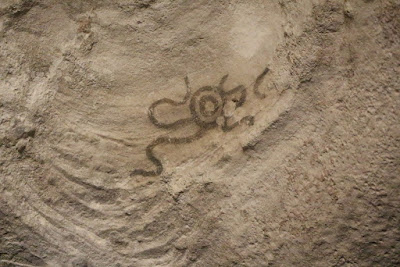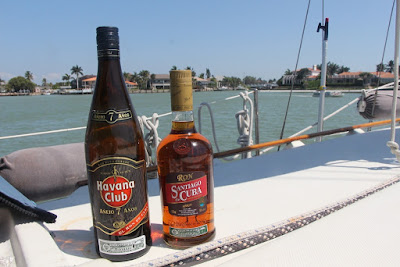Cuba was inhabited long before the
Spanish arrived. Archeological evidence
indicates that indigenous people arrived at least 4000 BCE from the Caribbean, Florida and
Mississippi. In fact the name for the
island is a Taïno word. It means "place
of abundant fertile land" or "great place." When
the Spanish arrived, the dominant inhabitants were the Tainos who had spread
throughout the Caribbean. Also present
were Ciboney and Guanajatabay. It is
estimated that about 350,000 indigenous people lived on the island when the
Spanish arrived. They raised sweet potatoes,
yucca, corn, cotton and tobacco. Harsh
treatment as slaves, disease and murder completely eliminated the
population. Today, there are no native
peoples in Cuba.
At some time in the
distant past, native people entered shallow caves and adorned the walls with
pictographs resembling serpents crossed with frogs or caricatures of ET. The caves themselves are interesting because
they rarely descend to great depths and the ceilings are perforated by openings
to the sky. Vines, roots and plants
spill from these openings like phantasmagoric waterfalls.
While broad flat plains stretch over large areas of
Cuba and merge with rolling hills, the island is home to three mountain
ranges. We took a bone-rattling ride in
an ancient Russian troop carrier up into the rain forest that cloaks the sides
of Sierra del Escambray, Cuba’s second largest range, near Trinidad.
High in the mountains is a region called “Topes
de Collante.” “Topes” means “limit” or
“brim” or “top” and Collante is a man’s name so the area is figuratively known
as the “Heights of Collante.”
It is a beautiful
area full of trees, flowers and mountain streams that cascade over rocky
outcrops into cold mountain pools.
Many
of the plants growing there have medicinal uses and are being studied by
pharmacologists. One in particular is a
mossy, vine like plant that hangs in streams from tree branches. A tea made from it lowers blood sugar and is
useful in controlling diabetes.
There are
coffee and banana plantations throughout the rainforest. They are not the manicured groves that you
might expect. Tiny coffee bushes share
space with the bananas and naturally occurring plants.
The overall effect is a certain kind of
wildness. Even though the plantations
seem untended, keeping the jungle back is a constant job and like so much else
in Cuba it’s done by hand and the machete is a farmer’s constant companion.
It is a hard life. Isolated farmhouses and well tended gardens dot
the hillsides. The coffee beans do not
all ripen at the same time. There are
three harvests during the season and the berries are picked one by one by hand.
Coffee is a
major export crop for Cuba. Like tobacco
and certain other crops, 80% of a farmer’s crop belongs to the government. The remaining 20% belongs to the farmer. The land upon which it is grown belongs to
the farmer as long as he works it and he can pass it on to his heirs. If he ceases to work the land, ownership
reverts to the government which will give it to someone else.
In many respects, life for the people who wrest a living from the land, like the land itself, has changed little over the years. Before the revolution, they worked hard, often and mostly manually. The same can be said today. They do have health care and they do have education. But like the mountains themselves, their way of life has endured.



































